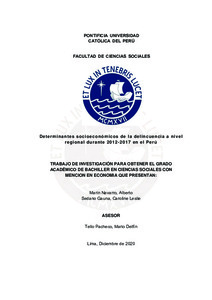| dc.contributor.advisor | Tello Pacheco, Mario Delfín | |
| dc.contributor.author | Marin Navarro, Alberto | |
| dc.contributor.author | Sedano Gauna, Caroline Leslie | |
| dc.date.accessioned | 2022-03-30T17:02:50Z | |
| dc.date.available | 2022-03-30T17:02:50Z | |
| dc.date.created | 2020 | |
| dc.date.issued | 2022-03-30 | |
| dc.identifier.uri | http://hdl.handle.net/20.500.12404/22007 | |
| dc.description.abstract | El presente trabajo analiza los determinantes de los delitos a nivel regional
durante el período 2012-2017. Es importante precisar que los delitos se pueden
definir a partir de su tipificación como tal en el Código Penal del Perú. En tal
sentido, el objetivo es identificar qué variables influyen en la comisión de un acto
delictivo, dado que existe mayor probabilidad de cometer actividades de esta
naturaleza si la persona posee un nivel de ingresos bajo. De esta manera, se
propone que los delitos dependen inversamente del nivel de ingresos y del nivel
de educación de la persona. Las teorías en las cuales se sustentan esta
investigación son la de economía del crimen de Becker (1968), el modelo de
participación en actividades ilegitimas de Ehrlich (1973) y la teoría de la privación
relativa de Ted Gurr (1970). Asimismo, el método utilizado es el de panel de
datos. Los resultados obtenidos fueron que las relaciones esperadas entre la
tasa de la delincuencia y los posibles determinantes de la teoría económica del
crimen no se cumplen en todos estos, al menos en el periodo de años 2012-
2017. | es_ES |
| dc.description.abstract | This paper analyzes the determinants of crimes at the regional level during the
period 2012-2017. It is important to specify that crimes can be defined based on
their classification as such in the Peruvian Penal Code. In this sense, the
objective is to identify which variables influence the commission of a criminal act,
since there is a greater probability of committing activities of this nature if the
person has a low income level. In this way, it is proposed that crimes depend
inversely on the level of income and the level of education of the person. The
theories on which this research is based are Becker's (1968) crime economy,
Ehrlich's (1973) model of participation in illegitimate activities, and Ted Gurr's
(1970) theory of relative deprivation. Also, the method used is the data panel.
The results obtained were that the expected relationships between the crime rate
and the possible determinants of the economic theory of crime are not fulfilled in
all of these, at least in the period of years 2012-2017. | es_ES |
| dc.language.iso | spa | es_ES |
| dc.publisher | Pontificia Universidad Católica del Perú | es_ES |
| dc.rights | info:eu-repo/semantics/openAccess | es_ES |
| dc.rights.uri | http://creativecommons.org/licenses/by/2.5/pe/ | * |
| dc.subject | Delincuencia--Aspectos sociales--Perú | es_ES |
| dc.subject | Delincuencia--Aspectos económicos--Perú | es_ES |
| dc.title | Determinantes socioeconómicos de la delincuencia a nivel regional durante 2012-2017 en el Perú | es_ES |
| dc.type | info:eu-repo/semantics/bachelorThesis | es_ES |
| thesis.degree.name | Bachiller en Ciencias Sociales con mención en Economía | es_ES |
| thesis.degree.level | Bachillerato | es_ES |
| thesis.degree.grantor | Pontificia Universidad Católica del Perú. Facultad de Ciencias Sociales | es_ES |
| thesis.degree.discipline | Ciencias Sociales con mención en Economía | es_ES |
| renati.advisor.dni | 06468348 | |
| renati.advisor.orcid | https://orcid.org/0000-0001-7929-0116 | es_ES |
| renati.author.dni | 75910496 | |
| renati.author.dni | 75929952 | |
| renati.discipline | 311016 | es_ES |
| renati.level | https://purl.org/pe-repo/renati/level#bachiller | es_ES |
| renati.type | https://purl.org/pe-repo/renati/type#trabajoDeInvestigacion | es_ES |
| dc.publisher.country | PE | es_ES |
| dc.subject.ocde | https://purl.org/pe-repo/ocde/ford#5.02.01 | es_ES |






